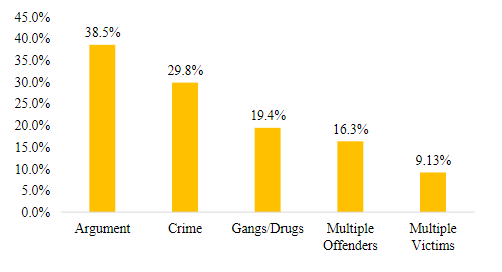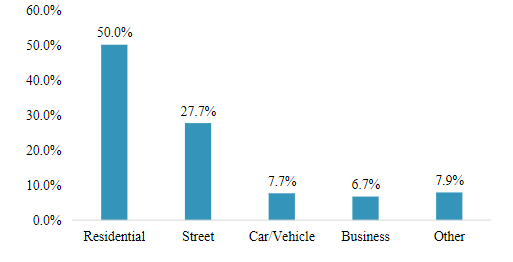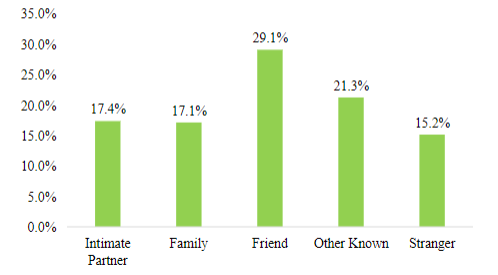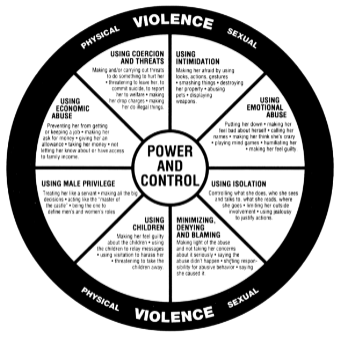Homicide
5.0(1)
Card Sorting
1/26
Earn XP
Description and Tags
Study Analytics
Name | Mastery | Learn | Test | Matching | Spaced |
|---|
No study sessions yet.
27 Terms
1
New cards
Risk Factors for Offending
* personality disorders
* substance use
* low SES
* unemployed parents
* broken home
* truancy
* low school achievement
* being held back a grade
* substance use
* low SES
* unemployed parents
* broken home
* truancy
* low school achievement
* being held back a grade
2
New cards
Instrumental Homicide
killing to achieve some other goal
* robbery
* gang violence
* drug trafficking
* terrorism
* robbery
* gang violence
* drug trafficking
* terrorism
3
New cards
Expressive Homicide
killing to alleviate emotional frustration and pressure
* domestic violence
* revenge
* instrumentality effect
* domestic violence
* revenge
* instrumentality effect
4
New cards
Situational Characteristics
* argument - 38.5%
* crime - 29.8%
* gangs/drugs - 19.4%
* multiple offender - 16.3%
* multiple victims - 9.13%
* crime - 29.8%
* gangs/drugs - 19.4%
* multiple offender - 16.3%
* multiple victims - 9.13%

5
New cards
Location
* residential - 50.0%
* street - 27.7%
* car/vehicle - 7.7%
* business - 6.7%
* other - 7.9%
* street - 27.7%
* car/vehicle - 7.7%
* business - 6.7%
* other - 7.9%

6
New cards
Victim-Offender Relationship
* intimate partner - 17.4%
* family - 17.1%
* friend - 29.1%
* other known - 21.3%
* stranger - 15.2%
* family - 17.1%
* friend - 29.1%
* other known - 21.3%
* stranger - 15.2%

7
New cards
Role of Guns
* instrumentality effect: guns are 15x more lethal than knives (second most deadly weapon)
* typically involve 2 young men of color who know each other (as friends or acquaintances) and get into an argument at home or on the street
* typically involve 2 young men of color who know each other (as friends or acquaintances) and get into an argument at home or on the street
8
New cards
Spikes in homicide rate over time mostly due to…
guns
1980s: crack cocaine epidemic
2019-2020: 35% increase in firearms homicide
1980s: crack cocaine epidemic
2019-2020: 35% increase in firearms homicide
9
New cards
Types of Homicide
* gang violence
* IPV
* Mass murder
* school shootings
* IPV
* Mass murder
* school shootings
10
New cards
Gangs
* formed in disadvantaged urban neighborhoods
* lack conventional opportunities for youth
* poor education
* single parent households
* poverty
* low life expectancy
* unsupervised youth hanging out on street corners
* lack conventional opportunities for youth
* poor education
* single parent households
* poverty
* low life expectancy
* unsupervised youth hanging out on street corners
11
New cards
Code of the Street
* violence becomes socially tolerated or even encouraged
* defending turf and illegal businesses
* promoting social status (masculinity)
* preventing victimization
* reputation is everything
* children socialized into gang life by parents
* “toughening up”
* defending turf and illegal businesses
* promoting social status (masculinity)
* preventing victimization
* reputation is everything
* children socialized into gang life by parents
* “toughening up”
12
New cards
Gang Violence
* alternate form of social control and economic opportunity
* provides protection
* acceptance in group
* sense of purpose
* mentorship from OGs
* drug trade as income
* conflict over turf
* usually a few blocks of violence
* small social networks
* organizational memory
* retaliatory homicide
* provides protection
* acceptance in group
* sense of purpose
* mentorship from OGs
* drug trade as income
* conflict over turf
* usually a few blocks of violence
* small social networks
* organizational memory
* retaliatory homicide
13
New cards
Complicated Communities
* tight knit where many “decent” folk have ties to gang members
* less fear: members not strangers
* act as community police and address local concerns
* part of local economy
* less fear: members not strangers
* act as community police and address local concerns
* part of local economy
14
New cards
Prevalence
* approx. 27,000 gangs and 770,000 members in the US
* 80% located in urban areas
* 60% of members are 18+
* gang members account for 0.2% of population, but 13% of all homicides
* nearly half of all homicides in major cities are gang-related
* 80% located in urban areas
* 60% of members are 18+
* gang members account for 0.2% of population, but 13% of all homicides
* nearly half of all homicides in major cities are gang-related
15
New cards
Gangs and Guns
* Relative to nonmembers, gang \n members are
* 3x more likely to own a gun for protection
* 4x more likely to carry guns
* More likely to have peers that own guns
* Gun carrying for protection against rivals creates an arms war
* “Firepower is the name of the \n game”
* Number and deadliness of guns increases gang’s reputation
* Gangs may actively recruit \n members with access to firearms
* Guns are used in 80-96% of gang \n homicides in major cities1
* Tend to be unplanned events rather than coordinated drive-bys
* 3x more likely to own a gun for protection
* 4x more likely to carry guns
* More likely to have peers that own guns
* Gun carrying for protection against rivals creates an arms war
* “Firepower is the name of the \n game”
* Number and deadliness of guns increases gang’s reputation
* Gangs may actively recruit \n members with access to firearms
* Guns are used in 80-96% of gang \n homicides in major cities1
* Tend to be unplanned events rather than coordinated drive-bys
16
New cards
Homicide rate surged ___ in metropolitan areas in 2020…but also increased ___ in rural areas
30%, 25%
17
New cards
example of a large city safer than rural areas
NYC
18
New cards
Role of Race
* POC overrepresented as both offenders and victims
* racial invariance assumption
* not inherently antisocial or violent
* individual-level risk factors operate similarly across racial/ethnic groups
* differences in offending/victimization rates are due to types of environments in which people live
* divergent social worlds
* racial invariance assumption
* not inherently antisocial or violent
* individual-level risk factors operate similarly across racial/ethnic groups
* differences in offending/victimization rates are due to types of environments in which people live
* divergent social worlds
19
New cards
IPV
* IPH accounts for 15% of __all__ homicides and 40% of femicides
* IPH is gendered
* 2/3 of all IPH involves men killing women
* IPH is gendered
* 2/3 of all IPH involves men killing women
20
New cards
Types of IPV
* situational couple violence
* intimate terrorism
* violent resistance
* intimate terrorism
* violent resistance
21
New cards
Coercive Control
* isolating from friends and family
* economic dependency
* threats and intimidation
* against children
* to commit suicide
* gaslighting
* economic dependency
* threats and intimidation
* against children
* to commit suicide
* gaslighting

22
New cards
Why don’t they leave?
* lack of financial resources due to forced dependency
* lack of social support from family/friends
* shame
* love for abuser and hope for future
* fear
* leaving is most dangerous time for a battered woman
* threats
* lack of social support from family/friends
* shame
* love for abuser and hope for future
* fear
* leaving is most dangerous time for a battered woman
* threats
23
New cards
Men Killing Women
* Male sexual proprietariness theory
* men believe they “own” women and their reproductive capabilities
* Use violence when genetic lineage is threatened
* Risk factors:
* jealousy/infidelity
* attempting to leave: 264% increase in homicide risk if she left in past year
* pregnancy
* men believe they “own” women and their reproductive capabilities
* Use violence when genetic lineage is threatened
* Risk factors:
* jealousy/infidelity
* attempting to leave: 264% increase in homicide risk if she left in past year
* pregnancy
24
New cards
Women Killing Men
* most often part of violent resistance to intimate terrorism
* victim precipitation occurs in 75% of female-perpetrated IPH incidents
* women 7x more likely than men to kill their partners in self-defense
* typically last resort/act of desperation
* female IPH offenders often attempt suicide, call police multiple times, and/or attempt to leave before committing homicide
* victim precipitation occurs in 75% of female-perpetrated IPH incidents
* women 7x more likely than men to kill their partners in self-defense
* typically last resort/act of desperation
* female IPH offenders often attempt suicide, call police multiple times, and/or attempt to leave before committing homicide
25
New cards
What About Guns?
* 3.5% of nonfatal IPV involves firearms, but 60% of IPH victims killed with guns
* perpetrators access to firearms increases likelihood of IPV turning deadly between 5x and 10x
* guns facilitate coercive \n control even when not \n being used to kill
* perpetrators access to firearms increases likelihood of IPV turning deadly between 5x and 10x
* guns facilitate coercive \n control even when not \n being used to kill
26
New cards
Firearms IPH rates have ___ 26% since 2010, but nonfirearms rate have ___
increased, declined
27
New cards
Stopping Abusers from Getting Guns
federal prohibitions for
* misdemeanor crime of domestic violence (MCDV)
* domestic violence restraining orders (DVRO)
but most states have no enforcement to make abusers relinquish their guns
* misdemeanor crime of domestic violence (MCDV)
* domestic violence restraining orders (DVRO)
but most states have no enforcement to make abusers relinquish their guns